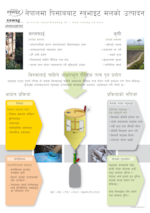Department Sanitation, Water and Solid Waste for Development
STruvite from Urine in Nepal (STUN)

From 2008 to 2012, the STUN project, in cooperation with UN-HABITAT Nepal, examined various possibilities to recover nutrients from source-separated urine.
Direct application of urine
Urine can be applied directly to crops. To avoid over-application of nutrients, leading to burning of the leaves, urine can be diluted with water in a ratio of 1:3.
Download Poster: Use urine fertilizer - boost soil fertility
Links:
Struvite precipitation from urine
Struvite (often called MAP for magnesium ammonium phosphate: MgNH4PO4·6H2O) is a safe, bio-available fertilizer, which can be precipitated from urine by adding magnesium. STUN developed a low-cost process to produce struvite. Conventional phosphate fertilizers are produced from phosphate rocks, a non-renewable resource. Alternative phosphate sources are necessary for a secure food production in the future.
Scientific Publications (Open Source)
Etter et al. 2011 - Low-Cost Struvite Production
Sakthivel et al. 2012 - Wood Ash as Magnesium Source
Brochures
How to Produce Fertilizer from Urine: English - नेपाली
Economics of Struvite Prodution in Nepal
Manuals
Low-Cost Struvite Reactor - Construction Manual
Low-Cost Struvite Reactor - Operation Manual
Drip irrigation cum urine fertilization = fertigation
When urine is applied to the field using a bucket or similar, ammonium is lost. To prevent this, urine or struvite process effluent can be applied with drip irrigation; the liquid flows through a set of hoses, no nutrients are lost on the way.
With a drip irrigation system, a maximum of water reaches the crops directly: you save time and water used for irrigation. From time to time, you may add urine to your irrigation system to provide your crops with nutrients.
Brochure: How to use urine in drip irrigation English - नेपाली
Report: Risk of clogging in urine fertigation
Links:
Aquatic plants fertilized with urine
Urine can be used to fertilize aquatic plants, such as Azolla or Lemna (Duckweed). These plants are rich in proteins and can be used as animal feed. The plants recover nutrients from the urine or struvite process effluent.
Nitrogen elimination with rotating discs
Ammonium in wastewater (e.g. urine) has a negative impact on streams, lakes and groundwater. Biological processes can be used to transform ammonia into less harmful nitrate or to remove ammonia completely.
To completely remove nitrogen from urine, either organic substrate has to be added or specialized bacteria - anaerobic ammonium oxidizers - have to be added (anammox process).
STUN developed a rotating biological contactor (RBC), which can be used for the biological treatment of domestic wastewater, urine or struvite production effluent.
Microbiological risk assessment in urine treatment
Links
Sustainable Sanitation
- Compendium of Sanitation in Developing Countries
- Ecological Sanitation Research
- Sustainable Sanitation and Water Management Toolbox
- Sustainable Sanitation Alliance
Urine separation and reuse
- Novaquatis - a trans-disciplinary research project on urine separation
- Valorization of Urine Nutrient in Africa - nutrient recovery in South Africa









